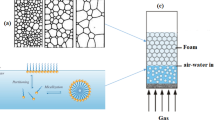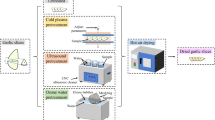Abstract
Liquisolid technology, as a promising approach for bioavailability enhancement, has received increasing attention in recent years. However, literature reports addressing the challenges for its industrial application, particularly those related to compaction behavior of liquisolid systems, are scarce. The aim of this study was to investigate the influence of process parameters and formulation variables on the flowability, wetting, and compaction properties of the liquisolid systems prepared in a fluid bed processor. The experiments with microcrystalline cellulose, as a carrier, were performed according to 23 full factorial design. The effects of liquid content, spray air pressure, and liquid feed rate on the properties of liquisolid systems were investigated. Liquisolid admixtures with microcrystalline cellulose were compared with those prepared with novel carriers, Fujicalin® and Neusilin® US2. “Out-die” Heckel, modified Walker, and Kuentz-Leuenberger models were used to analyze the compressibility of liquisolid admixtures. The results obtained showed that an increase in liquid content (in the range of 10 to 15%) led to a decrease in flowability of liquisolid admixtures with microcrystalline cellulose, as well as more pronounced influence of spraying conditions. On the other hand, higher liquid content led to higher compressibility. Fujicalin® and Neusilin® US2 liquisolid admixtures were found to have superior flowability and compressibility in comparison with those with microcrystalline cellulose, despite the considerably higher liquid load (50–55% liquid content in Neusilin® US2 compacts). Acceptable compactibility of the investigated liquisolid systems was observed. The fluid bed processor was shown to be suitable equipment for production of liquisolid systems, but with careful adjustment of process parameters.



Similar content being viewed by others
References
Spireas S, Bolton SM. Liquisolid systems and methods for preparing same. United States patent 5,800,834, 1998.
Spireas S. Liquisolid systems and methods for preparing same. United States patent 6,423,339 B1, 2002.
Javadzadeh Y, Siahi MR, Asnaashari S, Nokhodchi A. An investigation of physicochemical properties of piroxicam liquisolid compacts. Pharm Dev Technol. 2007;12:337–43.
Hentzschel CM, Sakmann A, Leopold CS. Suitability of various excipients as carrier and coating materials for liquisolid compacts. Drug Dev Ind Pharm. 2011;37(10):1200–7.
Vranikova B, Gajdziok J, Vetchy D. Determination of flowable liquid retention potential of aluminometasilicate carrier for liquisolid systems preparation. Pharm Dev Technol. 2015;20:839–44.
Jadhav NR, Irny PV, Patil US. Solid state behavior of progesterone and its release from Neusilin US2 based liquisolid compacts. J Drug Deliv Sci Technol. 2017;38:97–106.
Vranikova B, Gajdziok J. Evaluation of sorptive properties of various carriers and coating materials for liquisolid systems. Acta Pol Pharm Drug Res. 2015;72(3):539–49.
Nokhodchi A, Hentzschel CM, Leopold CS. Drug release from liquisolid systems: speed it up, slow it down. Expert Opin Drug Deliv. 2011;8(2):191–205.
Elkadi S, Elsamaligy S, Al-Suwayeh S, Mahmoud H. The development of self-nanoemulsifying liquisolid tablets to improve the dissolution of simvastatin. AAPS PharmSciTech. 2017;18(7):2586–97.
Pezzini BR, Beringhs AO, Ferraz HG, Silva MAS, Stulzer HK, Sonaglio D. Liquisolid technology applied to pellets: evaluation of the feasibility and dissolution performance using felodipine as a model drug. Chem Eng Res Des. 2016;110:62–9.
Gong W, Wang Y, Sun L, Yang J, Shan L, Yang M, et al. Development of itraconazole liquisolid compact: effect of polyvinylpyrrolidone on the dissolution properties. Curr Drug Deliv. 2016;13(3):452–61.
Javadzadeh Y, Navimipour BJ, Nokhodchi A. Liquisolid technique for dissolution rate enhancement of a high dose water-insoluble drug (carbamazepine). Int J Pharm. 2007;341:26–34.
Tayel SA, Soliman II, Louis D. Improvement of dissolution properties of carbamazepine through application of the liquisolid tablet technique. Eur J Pharm Biopharm. 2008;69:342–7.
Vittal GV, Deveswaran R, Bharath S, Basavaraj BV, Madhavan V. Formulation and characterization of ketoprofen liquisolid compacts by Box-Behnken design. Int J Pharm Investig. 2012;2(3):150–6.
Vranikova B, Gajdziok J, Vetchy D. Modern evaluation of liquisolid systems with varying amounts of liquid phase prepared using two different methods. Biomed Res Int. 2015;2015:608435. https://doi.org/10.1155/2015/608435.
Hentzschel CM, Alnaief M, Smirnova I, Sakmann A, Leopold CS. Enhancement of griseofulvin release from liquisolid compacts. Eur J Pharm Biopharm. 2012;80:130–5.
Tiong N, Elkordy AA. Effects of liquisolid formulations on dissolution of naproxen. Eur J Pharm Biopharm. 2009;73:373–84.
Spireas S, Wang T, Grover R. Effect of powder substrate on the dissolution properties of methyclothiazide liquisolid compacts. Drug Dev Ind Pharm. 1999;25(2):163–8.
Bolko Seljak K, German Ilić I, Gašperlin M, Zvonar PA. Self-microemulsifying tablets prepared by direct compression for improved resveratrol delivery. Int J Pharm. 2018;548:263–75.
Komala DR, Janga KY, Jukanti R, Bandary S. Competence of raloxifene hydrochloride loaded liquisolid compacts for improved dissolution and intestinal permeation. J Drug Deliv Sci Technol. 2015;30:232–41.
Badawy МА, Kamel АО, Sammour ОА. Use of biorelevant media for assessment of a poorly soluble weakly basic drug in the form of liquisolid compacts: in vitro and in vivo study. Drug Deliv. 2016;23(3):818–27.
Khaled KA, Asiri YA, El-Sayed YM. In vivo evaluation of hydrochlorothiazide liquisolid tablets in beagle dogs. Int J Pharm. 2001;222:1–6.
Khames A. Investigation of the effect of solubility increase at the main absorption site on bioavailability of BCS class II drug (risperidone) using liquisolid technique. Drug Deliv. 2017;24(1):328–38.
Khames A. Formulation and characterization of eplerenone nanoemulsion liquisolids, an oral delivery system with higher release rate and improved bioavailability. Pharmaceutics. 2019;11(1):40.
Jhaveri M, Nair AB, Shah J, Jacob S, Patel V, Mehta T. Improvement of oral bioavailability of carvedilol by liquisolid compact: optimization and pharmacokinetic study. Drug Deliv Transl Res. 2020;10:975–85. https://doi.org/10.1007/s13346-020-00734-3.
Sheta NM, Elfeky YA, Boshra SA. Cardioprotective efficacy of silymarin liquisolid in isoproterenol prompted myocardial infarction in rats. AAPS PharmSciTech. 2020;21:81. https://doi.org/10.1208/s12249-019-1609-3.
Patel K, Doddapaneni R, Patki M, Sekar V, Bagde A, Singh M. Erlotinib-valproic acid liquisolid formulation: evaluating oral bioavailability and cytotoxicity in erlotinib-resistant non-small cell lung cancer cells. AAPS PharmSciTech. 2019;20:135. https://doi.org/10.1208/s12249-019-1332-0.
Jyoti J, Anandhakrishnan NK, Singh SK, Kumar B, Gulati M, Gowthamarajan K, et al. A three-pronged formulation approach to improve oral bioavailability and therapeutic efficacy of two lipophilic drugs with gastric lability. Drug Deliv Transl Res. 2019;9:848–65.
Basalious EB, El-Sebaie W, El-Gazayerly O. Rapidly absorbed orodispersible tablet containing molecularly dispersed felodipine for management of hypertensive crisis: development, optimization and in vitro/in vivo studies. Pharm Dev Technol. 2013;18(2):407–16.
Moqbel HA, ElMeshad AN, El-Nabarawi MA. Comparative study of different approaches for preparation of chlorzoxazone orodispersible tablets. Drug Dev Ind Pharm. 2017;43(5):742–50.
Javadzadeh Y, Musaalrezaei L, Nokhodchi A. Liquisolid technique as a new approach to sustain propranolol hydrochloride release from tablet matrices. Int J Pharm. 2008;362:102–8.
Nokhodchi A, Aliakbar R, Desai S, Javadzadeh Y. Liquisolid compacts: the effect of cosolvent and HPMC on theophylline release. Colloids Surf B: Biointerfaces. 2010;79:262–9.
Kumar DS, Aparna C, Srinivas P. Immediate and mucoadhesive sustained release compacts of itraconazole using liquisolid technology. Int J Pharm Technol. 2015;7(3):9513–33.
Anzilaggo D, Beringhs AO, Pezzini BR, Sonaglioa D, Stulzera HK. Liquisolid systems: understanding the impact of drug state (solution or dispersion), nonvolatile solvent and coating material on simvastatin apparent aqueous solubility and flowability. Colloids Surf B: Biointerfaces. 2019;175:36–43.
Baranauskaite J, Kopustinskiene DM, Masteikova R, Gajdziok J, Baranauskas A, Bernatoniene J. Effect of liquid vehicles on the enhancement of rosmarinic acid and carvacrol release from oregano extract liquisolid compacts. Colloids Surf A. 2018;539:280–90.
Barmpalexis P, Grypioti A, Eleftheriadis GK, Fatouros DG. Development of a new aprepitant liquisolid formulation with the aid of artificial neural networks and genetic programming. AAPS PharmSciTech. 2018;19(2):741–52.
Fahmy RH, Kassem MA. Enhancement of famotidine dissolution rate through liquisolid tablets formulation: in vitro and in vivo evaluation. Eur J Pharm Biopharm. 2008;69:993–1003.
Suliman AS, Anderson RJ, Elkordy AA. Preparation of novel optimum liquisolid compacts via incorporating water granulation process to enhance the powder characterizations and dissolution behavior of a poorly soluble drug: Norfloxacin. Powder Technol. 2019;354:259–70.
Jaipakdee N, Limpongsa E, Sripanidkulchai B, Piyachaturawat P. Preparation of Curcuma comosa tablets using liquisolid techniques: in vitro and in vivo evaluation. Int J Pharm. 2018;553:157–68.
Kurek M, Woyna-Orlewicz K, Khalid MH, Jachowicz R. Optimization of furosemide liquisolid tablets preparation process leading to their mass and size reduction. Acta Pol Pharm Drug Res. 2016;73(5):1325–31.
Bonthagarala B, Dasari V, Kotra V, Swain S, Beg S. Quality-by-design based development and characterization of pioglitazone loaded liquisolid compact tablets with improved biopharmaceutical attributes. J Drug Deliv Sci Technol. 2019;51:345–55.
Aleksić I, Stanković N, Cvijić S, Parojčić J. An investigation into the characteristics of liquisolid systems prepared with microcrystalline cellulose and Neusilin® US2 as carriers. Proceedings of the 11th CESPT, 2016 September 22–24, Belgrade, Serbia. Arh Farm. 2016;66(Special Issue):83–4.
Aleksić I, Cvijić S, Parojčić J. An investigation into the characteristics of liquisolid systems prepared with spray dried calcium hydrogen phosphate as carrier. Proceedings of the 11th World Meeting on Pharmaceutics, Biopharmaceutics and Pharmaceutical Technology; 2018 Mar 19–22; Granada, Spain; 250 p.
European Pharmacopoeia 10th edition, Strasbourg: Council of Europe; 2019.
Heckel RW. Density-pressure relationship in powder compaction. Trans Metall Soc AIME. 1961;221:671–5.
Walker EE. The properties of powder VI: the compressibility of powders. Trans Faraday Soc. 1923;19:73–82.
Sonnergaard JM. Quantification of the compactibility of pharmaceutical powders. Eur J Pharm Biopharm. 2006;63:270–7.
Kuentz M, Leuenberger H. Pressure susceptibility of polymer tablets as a critical property: a modified Heckel equation. J Pharm Sci. 1999;88:174–9.
Fell JT, Newton JM. Determination of tablet strength by the diametral-compression test. J Pharm Sci. 1970;59:688–91.
Armstrong NA, Haines-Nutt RF. Elastic recovery and surface area changes in compacted powder systems. J Pharm Pharmacol. 1972;24:135–6.
Leturia M, Benali M, Lagarde S, Ronga I, Saleh K. Characterization of flow properties of cohesive powders: a comparative study of traditional and new testing methods. Powder Technol. 2014;253:406–23.
Emery E, Oliver J, Pugsley T, Sharma J, Zhou J. Flowability of moist pharmaceutical powders. Powder Technol. 2009;189:409–15.
Sandler N, Reiche K, Heinämäki J, Yliruusi J. Effect of moisture on powder flow properties of theophylline. Pharmaceutics. 2010;2:275–90.
Thalberg K, Lindholm D, Axelsson A. Comparison of different flowability tests for powders for inhalation. Powder Technol. 2004;146:206–13.
Lu M, Xing H, Yang T, Yu J, Yang Z, Sun Y, et al. Dissolution enhancement of tadalafil by liquisolid technique. Pharm Dev Technol. 2017;22:77–89.
Ilić I, Govedarica B, Šibanc R, Dreu R, Srčič S. Deformation properties of pharmaceutical excipients determined using an in-die and out-die method. Int J Pharm. 2013;446:6–15.
Grdešič P, Vrečer F, Ilić I. Flow and compaction properties of hypromellose: new directly compressible versus the established grades. Drug Dev Ind Pharm. 2016;42(11):1877–86.
Šantl M, Ilić I, Vrečer F, Baumgartner S. A compressibility and compactibility study of real tableting mixtures: the impact of wet and dry granulation versus direct tableting mixture. Int J Pharm. 2011;414:131–9.
Lamešić D, Planinšek O, German II. Modified equation for particle bonding area and strength with inclusion of powder fragmentation propensity. Eur J Pharm Sci. 2018;121:218–27.
Javadzadeh Y, Shariati H, Movahhed-Danesh E. Effect of some commercial grades of microcrystalline cellulose on flowability, compressibility, and dissolution profile of piroxicam liquisolid compacts. Drug Dev Ind Pharm. 2009;35:243–51.
Funding
This work was supported by the Ministry of Education, Science and Technological Development, Republic of Serbia (project 451-03-68/2020-14/200161).
Author information
Authors and Affiliations
Corresponding author
Additional information
Publisher’s Note
Springer Nature remains neutral with regard to jurisdictional claims in published maps and institutional affiliations.
Rights and permissions
About this article
Cite this article
Aleksić, I., German Ilić, I., Cvijić, S. et al. An Investigation into the Influence of Process Parameters and Formulation Variables on Compaction Properties of Liquisolid Systems. AAPS PharmSciTech 21, 242 (2020). https://doi.org/10.1208/s12249-020-01781-2
Received:
Accepted:
Published:
DOI: https://doi.org/10.1208/s12249-020-01781-2




